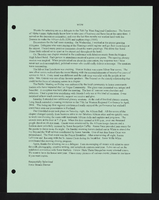Search the Special Collections and Archives Portal
Search Results
Jones, Clifford Aaron, Sr., 1912-2001
Nevada Lieutenant Governor Clifford "Cliff" Jones was born in Long Lane, Missouri in 1912. While he was attending the University of Missouri in 1931, his family moved to Las Vegas, Nevada. During summer breaks from college Jones worked alongside his brother, Herbert, on the construction of the Boulder (Hoover) Dam. Jones moved to Las Vegas in 1937 after he became an attorney.
Person
Rivera, Erma Linda, 1952-
Erma Linda Rivera was born in Morenci, Arizona, in 1952. In the Las Vegas Valley, where Linda has lived for over twenty years, she has promoted educational opportunities for youth, particularly in the Hispanic community. Both she and her husband moved from Montana, where her husband worked as a power plant operator on Yellowtail Dam, to southern Nevada to work on Hoover Dam in 1986. Linda was put in charge of the affirmative employment plan for her branch of the Bureau of Reclamation.
Person

Pearl Busch oral history interview
Identifier
Abstract
Oral history interview with Pearl Busch (born 1936 in Winona, Minnesota) conducted by Laura Busch on March 20, 1978 for the Ralph Roske Oral History Project on Early Las Vegas. Pearl first describes her original move to Southern Nevada and a wide range of topics including the first hotels on the Strip, the growth and expansion of the city, recreational activities such as skiing, and her family. She also discusses gambling and its impact on the city, the clubs and organizations to which she belonged, and her appreciation for the mild Las Vegas climate. The interview finalizes with her thoughts on the biggest excitement Las Vegas offers, her input on the high crime rate in Las Vegas, and her thoughts on the energy crisis and the future of solar energy in Las Vegas.
Archival Collection

Transcript of interview with Cecile Dotson Crowe by Darin Toldisky, April 27, 1981
Date
Archival Collection
Description
On April 27, 1981, Darin Toldisky interviewed Cecile Dotson Crowe (born October 17th, 1911, in Millville, Utah) at Clark County Library in Las Vegas, Nevada. This interview covers Mrs. Crowe’s account of the building of Hoover (Boulder Dam). Mrs. Crowe discusses the Six Companies, Boulder City, and recalls President Franklin Delano Roosevelt’s visit to Nevada by train to dedicate the dam on the 30th of September, 1937.
Text
Charles P. Squires Photograph Collection
Identifier
Abstract
The Squires Family Photographs document the Squires Family and the development of the Las Vegas Valley in Nevada from approximately 1860 to 1980, with a bulk of the photographs depicting people and events from 1900 to 1950. The photographs depict the Euro-American settlement and growth of Las Vegas, Nevada; traveling and exploration of Southern Nevada and the Southwestern United States; the Hoover (Boulder) Dam and the Colorado River; clubs and social groups; and the Squires Family, especially prominent newspaper editor and publisher Charles Pember (C. P. or “Pop”) Squires, Delphine “Mom” Anderson Squires, and their children.
Archival Collection

Theresa Thomas interview, March 13, 1995: transcript
Date
Archival Collection
Description
Thomas discusses her early life in Thistle, Utah before moving to Las Vegas, Nevada in approximately 1931, where her father worked on the Hoover Dam (Boulder Dam) construction. Thomas then talks about her early schooling in Boulder City, Nevada, her experiences as a swing and dance band musician, Block 16 in the Clark Las Vegas Townsite, and her memories of Las Vegas hotels and casinos. Other subjects Thomas covers include Las Vegas entertainers, entertainment venues, and women in the music industry during the 1930s.
Text

Alpha Kappa Alpha Sorority, Theta Theta Omega Chapter regional conference report
Date
Archival Collection
Description
From the Alpha Kappa Alpha Sorority, Incorporated, Theta Theta Omega Chapter Records (MS-01014) -- Chapter records file.
Text
Robert E. "Spud" Lake Photographs
Identifier
Abstract
The Robert E. "Spud" Lake Photographs depict "Spud" Lake, his family, and Las Vegas, Nevada from 1905 to 1947. The photographs include the Las Vegas town site auction, Stewart (Kiel) Ranch, Clark County Courthouse, Eglington Ranch, Helldorado Parade, and Colorado River and the Hoover (Boulder) Dam. The photographs also depict a Las Vegas Chamber of Commerce luncheon honoring Las Vegas pioneers, the Gold Bar Club tent in Pahrump, Nevada, and Fremont Street in Las Vegas.
Archival Collection

